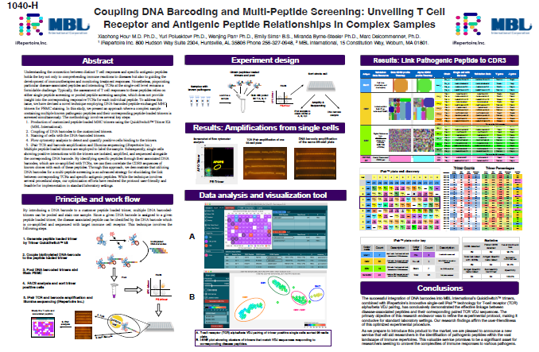Coupling DNA Barcoding and Multi-Peptide Screening: Unveiling T Cell
Receptor and Antigenic Peptide Relationships in Complex Samples
ABSTRACT: Understanding the connection between distinct T cell responses and specific antigenic peptides holds the key not only to comprehending immune reactions to diseases but also to guiding the development of immunotherapies and monitoring treatment responses. Nonetheless, pinpointing particular disease-associated peptides and interacting TCRs at the single-cell level remains a formidable challenge. Typically, the assessment of T cell responses to these peptides relies on either single peptide screening or pooled peptide screening samples, which does not provide insight into the corresponding responsive TCRs for each individual peptide. To address this issue, we have devised a novel technique employing DNA-barcoded peptide-exchanged MHC trimers for PBMC staining. In this study, we present an approach where a complex sample containing multiple known pathogenic peptides and their corresponding peptide-loaded trimers is screened simultaneously.
The methodology involves several key steps:
1. Production of customized peptide-loaded MHC trimers using the QuickSwitchTM Trimer Kit (MBL International).
2. Coupling of DNA barcodes to the customized trimers.
3. Staining of cells with the DNA-barcoded trimers.
4. Flow cytometry analysis to detect and quantify positive cells binding to the trimers.
5. iPair TCR and barcode amplification and Illumina sequencing (iRepertoire Inc.)
Multiple peptide-loaded trimers are employed to label the sample. Subsequently, single cells showing positive interactions with the trimers are isolated, amplified, and sequenced alongside the corresponding DNA barcode. By identifying specific peptides through their associated DNA barcodes, which are co-amplified with TCRs, we can then correlate the CDR3 sequences of known clones with each of these peptides. Through this approach, we demonstrate that utilizing DNA barcodes for a multi-peptide screening is an advanced strategy for elucidating the link between corresponding TCRs and specific antigenic peptides. While the technique involves several procedural steps, our optimization efforts have rendered the protocol user-friendly and feasible for implementation in standard laboratory settings.
Please contact us for help to set up your unique experiments.
